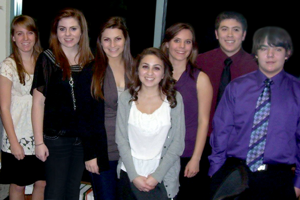Youth Peer Court
Investing In The Future of Our Youth.
YOUTH PEER COURT: Shasta County Youth Peer Court has been investing in the future of our youth since October 2003. Youth Peer Court is a program of Youth Violence Prevention Council now known as Youth options Shasta. Youth Options Shasta provides a means by which first time juvenile offenders could be diverted from the traditional juvenile justice system into a program which practices restorative, rather than punitive justice. By agreeing to participate in the program, the offenders, called respondents, have the opportunity to have their cases heard before a jury of their peers. If the respondent successfully completes his or her sentence and does not reoffend while in the program, the record for that offense is cleared. The peer jurors and attorneys in Youth Peer Court are youths between the ages of 13-18 from middle and high schools throughout Shasta County.
Youth Peer Court also provides an opportunity for a broad segment of middle and high school aged students throughout the county to learn about the rights and responsibilities of individuals in our legal system. This helps students to make more informed choices in the way they conduct their personal lives. Through volunteering as jurors, jury forepersons, and student attorneys, they are able to help respondents by deciding on a variety of restorative options that are available as part of the sentence. They hold the respondents accountable for their actions, provide classes and other positive options. This empowers youth and teaches them valuable skills while they in turn help other youth and thus are less likely to reoffend in the future.
MISSION: The mission of Shasta County Youth Peer Court is to create a restorative justice program that incorporates a balanced approach to youth justice focusing accountability, competency development, and community protection rather than punishment.
JURORS: The jury is comprised of students from both middle and high schools from ages 13-18. The jury is a combination of volunteer jurors and respondents who are required as part of their sentence to come back and serve on the jury. This gives the respondent jurors an opportunity to help other youth by assisting in the jury process and helping to create appropriate and meaningful restorative plan for other respondents. Jury Forepersons are chosen to preside over the jury deliberation process, and this teaches youth valuable leadership and communication skills.
The Youth Peer Court does not determine guilt or innocence, since one of the requirements for a youth to appear in front of the court is a acceptance taking responsibility for one’s actions. The jury’s job, therefore, is to assign a restorative plan that will benefit both the respondent and the community. The types of offenses that appear in the court are theft, vandalism, drug and alcohol offenses, assault and battery, cyber-related crimes and school based offenses.
All Court proceedings are open to the public. Attendees are required to keep the names and details of what they hear in court confidential. We encourage you to attend a trial if you are interested in finding out more information contact the Peer Court Coordinator at info@yoshasta.org or call 530-244-7194 .
PEER COURT DRESS CODE: The Youth Peer Court conduct, respect and dress code policies applies to respondents, jury members, student attorneys, and Peer Court Staff. Youth Peer Court Student attorneys are leading examples to their fellow peers and held to the highest esteem. Students are required to dress in business attire at all times. Always be well-groomed and wear clean clothing, free of holes, tears, or other signs of wear.
DRESS CODE POLICY: (you will not be allowed on jury duty if wearing the following items)

Hoodies • Shorts • Exposed undergarments • Combat boots • Tank tops, spaghetti straps, strapless shirts • Midriffs showing or revealing shirts • Miniskirts or extremely short dresses • T-shirts with offensive/controversial logos • Ball caps • Blue jeans (ripped or excessively faded) • Undershirts • Baggy pants • Camouflage clothing • Spikes • Trench coats • Any gang related clothing • Bandanas • Sunglasses • Excessive jewelry
RESTORATIVE JUSTICE: SEVEN STEPS TO DELIBERATION: The most effective jurors are those who can readily identify all the positive options and understand how each is related to Restorative Justice and the 40 Developmental Assets. You should ask questions and make comments during deliberations that will help to ensure that the restorative plan will help the respondents to understand how their actions affected others. Your goal is to give a sentence that creates opportunities for the respondent to repair the harm, increase their skills, and involve the community.
- Review the rules for jury deliberations.
- Review the facts and circumstances of the case. Discuss your impressions of what you saw and heard during the hearing.
- Decide who was affected by the respondent’s actions and how they were harmed by the respondent.
- Identify the needs of everyone who was affected by the harm: respondent, respondent’s family, victims, and the community.
- Decide what needs to be done to repair the harm.
- Determine an appropriate sentence that will help meet the needs of the affected parties and reach mutual agreement.
- Provide a restorative plan and an explanation in a written statement that will send a message to the respondent about the jury’s thoughts and impressions, as well as their hopes for successful completion of the program.
Make the choice to make a difference, become part of peer court!

